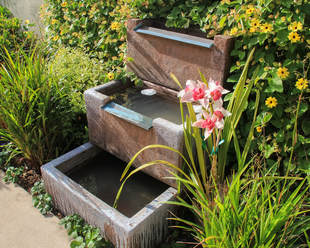steve harbour landscapes
Landscape Designer Steve Harbour Offers the best in affordable residential landscapes to San Diego County homeowners. .
 This landscape vignette in La Jolla, CA was designed to bloom throughout the four seasons. This landscape vignette in La Jolla, CA was designed to bloom throughout the four seasons. The rainy season is here! Or is it? It is now late December and barely a drop of rain has fallen during the current, supposed wet period. Without any rain, we still have our irrigation clocks set in the “on” position, waiting for Mother Nature to send some clouds our way. But before we get too gloomy, this is San Diego, where sunshine and warm temps rule most days. Maybe it’s time to get out and begin that landscape project you have been dreaming about. Some folks assume they need to postpone planting now with the onset of winter. But as long as those landscapes are not located in the eastern foothills or low lying inland valleys, winter in San Diego is often one of the best times to plant. The cool temperatures and reoccurring rains combine to gently acclimatize transplants. This is especially true with native plants and other northern hemisphere drought tolerants. Genetically, these plants are programmed to not expect much water in the dry season, but naturally thrive in winter rains. Our moderate weather now helps plants acclimatize and root without nearly as much supplemental water as needed spring through fall, saving on water bills even if the rains don’t completely do the job. The new transplants will root fully and be ready to take advantage of the entire growing season by spring. One unlikely but possible caveat can thwart plans: the unlikely but still possible cold snap that seems to hit every few years. These unusually severe frosts (by San Diego standards) can affect plants all the way to the coast. But by planting the right plants to survive these frosts, and throwing a blanket over susceptible plants like citrus or bougainvillea, the homeowner can ensure the landscapes stay in good shape through these unlikely yet still possible severe cold periods. In my experience, these extreme cold snaps usually take place in late December or early January and only last a couple days. This slim possibility should not postpone a project. Why wait for warmer weather? Our mild climate makes landscaping a year-around possibility and winter a good time to get plants into the ground and ready for spring. Designers and installers do not have lengthy backlogs of work at this time of year. Why wait to renew the landscape?
0 Comments
 The WUCOLS list helps pros and clients alike understand water needs of plants. The WUCOLS list helps pros and clients alike understand water needs of plants. What are WUCOLS? Perhaps you have puzzled over this term when beginning a new landscape. The term stands for Water Use Classification of Landscape Species. Landscape designers in California use this term with clients when discussing plant water needs and irrigation design. Or a WUCOLS list could show up on your landscape plan, typically as a column in the plant legend. Or, if you live in a highly regulated city, you may just have to produce a WUCOLS list for the city planning department in order to proceed with your landscape. Before turning and running for the nearest exit, reassure yourself that the work of determining WUCOLS in a landscape has already been done for you and can easily be found online. Here are 10 basics to know about WUCOLS:
 The demand for outdoor living spaces like this backyard in Encinitas, CA, is increasing dramatically according to the latest AIA survey. The demand for outdoor living spaces like this backyard in Encinitas, CA, is increasing dramatically according to the latest AIA survey. What’s trending in landscape design? Here in San Diego and elsewhere, it’s outdoor rooms. The latest 2017 survey provided by the American Institute of Architects (AIA) lists outdoor rooms as the most popular type of room addition (37%) for homeowners thinking of adding rooms to their property, beating out mudrooms and man caves among others. No surprise here in the land of sunshine, outdoor living rooms have only become more popular in San Diego; the percentage of folks dreaming of a roofed overhead -- outdoor fireplace, outdoor kitchen, and a multitude of outdoor luxuries --increases daily. The AIA survey shows more than two-thirds of architect firms seeing a rise in the demand for outdoor living spaces. Interestingly, 61% noticed more clients wanting their outdoor spaces to sync with the indoors. Mirroring elements in the outdoor landscape to the home and interior has always been a postulate of good home and garden design, so this high percentage is a sign that clients are becoming more educated and demanding spaces that mix harmoniously. Additionally, about one-third of the firms saw an uptick in the desire for outbuildings and also for exterior/security lighting. Another interesting statistic to be gleaned, especially here in San Diego with our hills, mesas, and canyons, 56% of the respondents noted an increase in properties with complex grading and removal challenges. This is likely the result of homeowners (and developers) desiring as much usable outdoor space as possible. And the final trend at the heart of San Diego’s new landscapes: drought tolerant plantings, termed “low irrigation landscaping” presumably to also include drip and microspray irrigation, was noted by 55% of those included in the poll. The trend continues in San Diego -- homeowners installing new landscapes want designers to plan highly functional outdoor living spaces with beautiful, drought tolerant gardens. |
Categories |